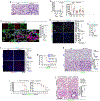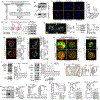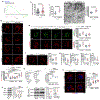CD151 Maintains Endolysosomal Protein Quality to Inhibit Vascular Inflammation
- PMID: 38557119
- PMCID: PMC11081830
- DOI: 10.1161/CIRCRESAHA.123.323190
CD151 Maintains Endolysosomal Protein Quality to Inhibit Vascular Inflammation
Abstract
Background: Tetraspanin CD151 is highly expressed in endothelia and reinforces cell adhesion, but its role in vascular inflammation remains largely unknown.
Methods: In vitro molecular and cellular biological analyses on genetically modified endothelial cells, in vivo vascular biological analyses on genetically engineered mouse models, and in silico systems biology and bioinformatics analyses on CD151-related events.
Results: Endothelial ablation of Cd151 leads to pulmonary and cardiac inflammation, severe sepsis, and perilous COVID-19, and endothelial CD151 becomes downregulated in inflammation. Mechanistically, CD151 restrains endothelial release of proinflammatory molecules for less leukocyte infiltration. At the subcellular level, CD151 determines the integrity of multivesicular bodies/lysosomes and confines the production of exosomes that carry cytokines such as ANGPT2 (angiopoietin-2) and proteases such as cathepsin-D. At the molecular level, CD151 docks VCP (valosin-containing protein)/p97, which controls protein quality via mediating deubiquitination for proteolytic degradation, onto endolysosomes to facilitate VCP/p97 function. At the endolysosome membrane, CD151 links VCP/p97 to (1) IFITM3 (interferon-induced transmembrane protein 3), which regulates multivesicular body functions, to restrain IFITM3-mediated exosomal sorting, and (2) V-ATPase, which dictates endolysosome pH, to support functional assembly of V-ATPase.
Conclusions: Distinct from its canonical function in strengthening cell adhesion at cell surface, CD151 maintains endolysosome function by sustaining VCP/p97-mediated protein unfolding and turnover. By supporting protein quality control and protein degradation, CD151 prevents proteins from (1) buildup in endolysosomes and (2) discharge through exosomes, to limit vascular inflammation. Also, our study conceptualizes that balance between degradation and discharge of proteins in endothelial cells determines vascular information. Thus, the IFITM3/V-ATPase-tetraspanin-VCP/p97 complexes on endolysosome, as a protein quality control and inflammation-inhibitory machinery, could be beneficial for therapeutic intervention against vascular inflammation.
Keywords: cell adhesion; endothelial cells; multivesicular bodies; proteolysis; ubiquitin.
Conflict of interest statement
Figures






References
-
- Hemler ME. Tetraspanin proteins promote multiple cancer stages. Nature Reviews Cancer. 2014;14:49–60 - PubMed
-
- Sterk LM, Geuijen CA, van den Berg JG, Claessen N, Weening JJ, Sonnenberg A. Association of the tetraspanin cd151 with the laminin-binding integrins alpha3beta1, alpha6beta1, alpha6beta4 and alpha7beta1 in cells in culture and in vivo. Journal of cell science. 2002;115:1161–1173 - PubMed
-
- Orlowski E, Chand R, Yip J, Wong C, Goschnick MW, Wright MD, Ashman LK, Jackson DE. A platelet tetraspanin superfamily member, cd151, is required for regulation of thrombus growth and stability in vivo. Journal of thrombosis and haemostasis : JTH. 2009;7:2074–2084 - PubMed
Publication types
MeSH terms
Substances
Grants and funding
LinkOut - more resources
Full Text Sources
Medical
Molecular Biology Databases
Miscellaneous

